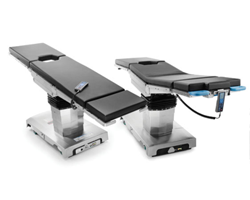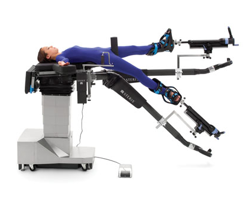Ultimate Guide to Operating Table
What is an Operating Table?
An operating table is a table on which a patient lies during a surgical procedure. Sometimes known as a surgical table or operation table, operating tables are typically used within an operating room or surgical suite of a hospital, ambulatory surgery center, or other healthcare facilities where surgeries are performed. Operating tables may be either stationary or mobile to move room to room. Operating tables are used in various types of procedures such as cardiothoracic, orthopedic, bariatric, robotic, urologic, and more.
Uses of an Operating Table
The uses of an operating table depend on its design and specifications. For example, some operating tables are designed to perform a wide range of procedures while others are designed specifically for orthopedic procedures. A patient lies on the operating table during a surgical procedure. The purpose of a surgical table is to keep the patient in place while the surgical team operates, and may move various parts of the body using surgical table accessories for easier access to the surgical site.
Countless procedures are performed on operating tables. These include cardiovascular, gynecology, pediatric, orthopedic, and pediatric surgeries. Because of the variety of procedures and types of surgical tables, weight and height restrictions are set to keep the patient safe during surgery.
Explore our Operating Tables
Types of Operating Tables
There are three major categories of operating tables: general surgical tables, orthopedic tables, and radiolucent imaging tables.
General surgical tables are used in a wide variety of surgical procedures like cardiovascular, pediatric, gynecology, gall bladder, and plastic surgery. A general surgical table does not have one specialty. Instead, it is designed for versatility and adaptability across a wide array of operations. General surgical tables can be adjusted for height and length, can be tilted to either side, and tilted horizontally. On most general tables, the head section is removable and can have a variety of attachable head rests.1
Explore our General Surgical Tables
The second type of operating table, the orthopedic table, is designed for easy manipulation and maneuverability required in orthopedic surgeries. To successfully perform an orthopedic surgery, surgeons need precise control and flexibility while maneuvering the patient. Orthopedic tables allow this access and flexibility of movement.
Explore our Orthopedic Surgical Tables
The third type of operating table is the radiolucent imaging table. This type of table is designed for minimally invasive procedures that require fluoroscopy. Some of these procedures may be endovascular, vascular, or pain management. Radiolucent imaging tables are ideal for procedures that require clear, high-quality imaging.
Explore our Radiolucent Surgical Tables
The Best Operating Tables
While there is not one perfect operating table, choosing the right operating table for each surgical procedure is important for patient safety and successful outcomes in the operating room. The decision to use a certain operating table over another depends on patient risk factors, positioning abilities, type of procedure, and length of procedure. Some features of good surgical tables include versatility, ease of use, reliability, generous weight and height restrictions, and accessory capabilities.
Common Surgical Positions for Operating Tables
Surgical procedures require proper patient positioning to keep the patient comfortable and safe during surgery, and to provide the surgeon with easy, unobstructed access to the surgical site. Many factors influence the decision of how to position a patient during a procedure:
- The patient's overall condition
- Length of procedure
- Techniques to be used during procedure
- Required exposure at operative site
- Expected anatomical and physiological changes associated with anesthesia
Furthermore, there are various risk factors that may lead to a patient's vulnerability to injury from improper positioning, such as:
- Long procedures (3+ hours)
- Bone and joint conditions
- Skin breakdown due to aging
- Malnutrition, hypovolemia, anemia, paralysis, obesity, extreme thinness, or diabetes
The most common surgical positions are supine, Trendelenburg, reverse Trendelenburg, prone, lithotomy, sitting and lateral positions.
- Supine Position: This position is the natural position of the body at rest, making it the most common posture for surgery. Common complications associated with the supine position are backaches and pressure-point reactions.
- Trendelenburg Position: The Trendelenburg position is a variation of the supine position. The upper torso is lowered and the feet raised, allowing for optimal visualization of the pelvic organs during laparoscopy and lower abdominal procedures.
- Reverse Trendelenburg Position: Commonly known as the head-up and feet-down position, the reverse Trendelenburg is often used in head and neck procedures
- Prone Position: In this position, the patient lies flat on their stomach and their head is turned to the side. This position is most commonly used for cervical spine, back, and rectal area procedures.
- Lithotomy Position: While in the lithotomy position, the patient is in supine position and their legs are raised and abducted. Stirrups are needed for this position.
- Fowler's Position: Also known as the Sitting position, the patient in this position is sitting at a 90 degree angle. The knees are slightly flexed and the feet are placed against a padded foot board. This position is ideal for neurosurgery, facial operations, and some shoulder surgeries.
- Lateral Position: The lateral position places the patient on the non-operative side to that surgery can be performed on the hip, chest, or kidney.1
Operating Tables vs. Surgical Tables
An operating table and surgical table are synonymous. Operating tables are also commonly known as surgical tables, surgical operating tables, surgery tables, and operation theater tables.
1 https://university.steris.com/course/interoperative-patient-positioning-its-more-than-just-comfort/
 United States
United States
 Canada (EN)
Canada (EN) Canada (FR)
Canada (FR) Deutschland
Deutschland Italia
Italia United Kingdom
United Kingdom Australia
Australia New Zealand
New Zealand Singapore
Singapore Brasil
Brasil México
México





